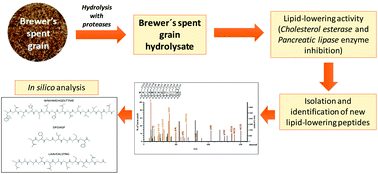Isolation and identification of cholesterol esterase and pancreatic lipase inhibitory peptides from brewer's spent grain by consecutive chromatography and mass spectrometry
Abstract
The isolation and identification of cholesterol esterase (CE) and pancreatic lipase (PL) inhibitory peptides obtained from the protein hydrolysate of brewer's spent grain (BSG) was performed. BSG peptides were fractionated and purified sequentially by anion exchange, gel filtration (FPLC), and reversed phase high-performance liquid chromatography (RP-HPLC). The fractions obtained from each chromatographic step were collected and the in vitro enzyme inhibitory activity was evaluated. The chromatographic purification process increased the in vitro activities. The most active fractions were evaluated using MALDI-TOF tandem mass spectrometry, which identified three peptides: a peptide with the highest CE inhibition capacity (WNIHMEHQDLTTME) and two peptides with PL inhibition capacity (DFGIASF and LAAVEALSTNG). These three peptides showed hydrophobic and acidic amino acid residues (Asp and Glu) and/or their amines (Asn and Gln), which could be a common feature among lipid-lowering peptides related to CE and PL enzyme inhibition. The in silico studies showed that the three peptides had high hydrophobicity and were susceptible to enzymatic hydrolysis performed by trypsin, pepsin, and pancreatin. The BSG byproduct was a good source of CE and PL inhibitory peptides, thus adding value to this byproduct of the beer industry. This is the first report to demonstrate that BSG peptides can inhibit CE and PL enzymes.

- This article is part of the themed collection: Food & Function Recent HOT articles


 Please wait while we load your content...
Please wait while we load your content...